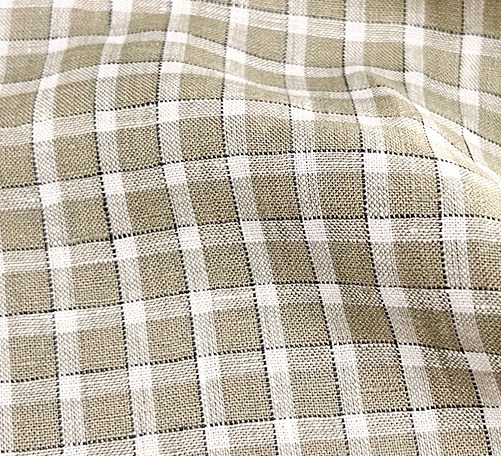How to Identify the Quality of Raw Linen Fabric
Linen, made from the fibers of the flax plant, has been treasured for centuries due to its durability, breathability, and natural elegance. Among various types of linen, raw linen fabric stands out for its untouched and minimally processed state, preserving the authentic characteristics of flax. Whether you're sourcing raw linen for fashion, upholstery, or artisanal crafts, knowing how to assess its quality is crucial to ensure performance, longevity, and customer satisfaction.
Fiber Origin and Purity
The foundation of high-quality raw linen starts with the origin of the flax fibers. European-grown flax—particularly from France, Belgium, and the Netherlands—is globally recognized for its long, strong, and fine fibers. The purity of the fibers also matters. Check if the fabric is 100% linen or blended with other materials like cotton or synthetic fibers, which can reduce its quality and alter its properties.
How to Check:
Inspect the label or request a fabric specification sheet from the supplier.
Perform a burn test: Linen burns like paper, producing ash and a smell similar to burning grass or wood.
Look at the fabric under natural light for uniform fiber structure and natural sheen.
Thread Count and Weave Density
While thread count is often discussed in cotton textiles, in linen it also plays a role in evaluating quality. Higher thread count combined with tight weave density typically indicates a stronger and smoother fabric surface. However, raw linen may have lower thread counts due to its coarse nature, so the emphasis shifts to consistency in weaving and strength of the threads.
What to Look For:
Even weave with minimal slubs or gaps.
No excessive fraying at the edges.
Firm but flexible texture.
Slubs and Texture: Natural vs. Excessive
Linen fabric naturally features "slubs"—small knots or lumps in the fiber—which are not defects but signatures of linen's authenticity. However, excessively large or inconsistent slubs may suggest poor spinning or low-quality processing.
Best Practice:
Feel the fabric: Quality raw linen has an organic, uneven texture but should still feel cohesive and not overly coarse.
Visually inspect for irregular patterns that break the fabric’s continuity.
Color and Natural Finish
Raw linen is typically unbleached and undyed, resulting in colors ranging from ivory to light gray or beige. The color uniformity and finish of raw linen tell a lot about its processing. A clean, matte appearance without yellowing or patchiness often suggests careful retting and minimal contamination.
Avoid if:
The fabric shows uneven discoloration.
There are visible residues or chemical smells indicating artificial treatments.
Strength and Durability Test
Linen is one of the strongest natural fibers. Quality raw linen should be able to withstand tension and abrasion without tearing. A quick manual strength test can help:
How to Test:
Tug the fabric lightly across the grain—minimal deformation indicates higher quality.
Rub a sample between your fingers—poor-quality linen may pill or shed fibers quickly.

Moisture Absorption and Breathability
One of the most praised attributes of linen is its moisture-wicking and breathable nature. Good-quality raw linen can absorb up to 20% of its weight in moisture without feeling damp, making it ideal for hot climates and summer garments.
Simple Tip:
Sprinkle a few drops of water on the fabric. Quality linen will absorb them quickly and dry evenly without leaving stains or patches.
Shrinkage Potential
Because raw linen is not pre-shrunk, it's important to understand how it behaves when washed. While some shrinkage is natural, excessive or uneven shrinkage signals poor fabric quality or inconsistent fiber tension during weaving.
Advice:
Always ask for pre-wash shrinkage data.
Wash a small swatch before bulk purchasing or tailoring.
Ethical Sourcing and Sustainability
Increasingly, buyers are evaluating textiles not just for physical quality but also for sustainable practices and ethical sourcing. Top-quality raw linen often comes from farms that use rain-fed irrigation, low pesticide input, and traditional retting methods without harsh chemicals.
What to Check:
Certifications like OEKO-TEX, GOTS (if organic), or European Flax®.
Information about the flax origin and processing methods.
Price vs. Quality Balance
Price can be a helpful indicator, though not definitive. Extremely cheap linen may be machine-processed with poor-quality fibers, while high price tags should reflect fiber origin, craftsmanship, and sustainability. Always compare fabric samples from multiple suppliers and understand what factors influence cost:
Country of origin
Fiber length and grade
Weaving technique
Pre-treatment and finishing steps
Supplier Transparency and Testing
Finally, a reliable way to ensure the quality of raw linen fabric is to work with transparent, professional suppliers who can offer detailed product specifications, quality certificates, and even lab testing reports for:
Tensile strength
Color fastness
Dimensional stability
Fabric composition
Request samples, perform basic tests, and don’t hesitate to ask in-depth questions. High-quality raw linen suppliers are typically happy to educate and collaborate.
Identifying the quality of raw linen fabric involves a combination of sensory evaluation, technical assessment, and supplier insight. From checking fiber origin to testing durability and breathability, every step helps ensure that the linen you choose will deliver the natural beauty and functionality this ancient textile is known for.
When you invest in premium-quality raw linen, you're not only getting a fabric—but a story of nature, craftsmanship, and enduring performance.
For more textile sourcing inquiries or fabric specifications, feel free to contact via email: [email protected]
[email protected]
[email protected]


 中文简体
中文简体 Français
Français Deutsch
Deutsch italiano
italiano
 previous post
previous post






















